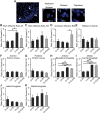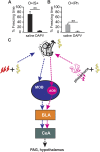Pheromone-Induced Odor Associative Fear Learning in Rats
- PMID: 30532054
- PMCID: PMC6286391
- DOI: 10.1038/s41598-018-36023-w
Pheromone-Induced Odor Associative Fear Learning in Rats
Abstract
Alarm pheromones alert conspecifics to the presence of danger. Can pheromone communication aid in learning specific cues? Such facilitation has an evident evolutionary advantage. We use two associative learning paradigms to test this hypothesis. The first is stressed cage mate-induced conditioning. One pair-housed adult rat received 4 pairings of terpinene + shock over 30 min. Ten minutes after return to the home cage, its companion rat was removed and exposed to terpinene. Single-housed controls were exposed to either terpinene or shock only. Companion rats showed terpinene-specific freezing, which was prevented by β-adrenoceptor blockade. Using Arc to index neuronal activation in response to terpinene re-exposure, stressed cage-mate induced associative learning was measured. Companion rats showed increased neuronal activity in the accessory olfactory bulb, while terpinene + shock-conditioned rats showed increased activity in the main olfactory bulb. Both groups had enhanced activity in the anterior basolateral amygdala and central amygdala. To test involvement of pheromone mediation, in the 2nd paradigm, we paired terpinene with soiled bedding from odor + shock rats or a rat alarm pheromone. Both conditioning increased rats' freezing to terpinene. Blocking NMDA receptors in the basolateral amygdala prevented odor-specific learning suggesting shock and pheromone-paired pathways converge in the amygdala. An alarm pheromone thus enables cue-specific learning as well as signalling danger.
Conflict of interest statement
The authors declare no competing interests.
Figures




Similar articles
-
Enduring effects of infant memories: infant odor-shock conditioning attenuates amygdala activity and adult fear conditioning.Biol Psychiatry. 2007 Nov 15;62(10):1070-9. doi: 10.1016/j.biopsych.2007.04.025. Epub 2007 Sep 10. Biol Psychiatry. 2007. PMID: 17826749
-
Shared Pheromonal Communication of Specific Fear Between Adult Sprague Dawley Rats.Bio Protoc. 2020 Mar 20;10(6):e3564. doi: 10.21769/BioProtoc.3564. eCollection 2020 Mar 20. Bio Protoc. 2020. PMID: 33659535 Free PMC article.
-
Glutamate receptor antagonist infusions into the basolateral and medial amygdala reveal differential contributions to olfactory vs. context fear conditioning and expression.Learn Mem. 2005 Mar-Apr;12(2):120-9. doi: 10.1101/lm.87105. Epub 2005 Mar 17. Learn Mem. 2005. PMID: 15774945 Free PMC article.
-
Ontogeny of odor-LiCl vs. odor-shock learning: similar behaviors but divergent ages of functional amygdala emergence.Learn Mem. 2009 Jan 29;16(2):114-21. doi: 10.1101/lm.977909. Print 2009 Feb. Learn Mem. 2009. PMID: 19181617 Free PMC article.
-
Rodent model of infant attachment learning and stress.Dev Psychobiol. 2010 Nov;52(7):651-60. doi: 10.1002/dev.20482. Dev Psychobiol. 2010. PMID: 20730787 Free PMC article. Review.
Cited by
-
How to Control Behavioral Studies for Rodents-Don't Project Human Thoughts onto Them.eNeuro. 2021 Jan 29;8(1):ENEURO.0456-20.2021. doi: 10.1523/ENEURO.0456-20.2021. Print 2021 Jan-Feb. eNeuro. 2021. PMID: 33468539 Free PMC article.
-
Reciprocal processes of sensory perception and social bonding: an integrated social-sensory framework of social behavior.Genes Brain Behav. 2022 Mar;21(3):e12781. doi: 10.1111/gbb.12781. Epub 2021 Dec 14. Genes Brain Behav. 2022. PMID: 34905293 Free PMC article. Review.
-
Pheromone components affect motivation and induce persistent modulation of associative learning and memory in honey bees.Commun Biol. 2020 Aug 17;3(1):447. doi: 10.1038/s42003-020-01183-x. Commun Biol. 2020. PMID: 32807870 Free PMC article.
-
Context-dependent effects of formic acid on olfactory learning and generalisation in ants.Sci Rep. 2025 Jul 10;15(1):24891. doi: 10.1038/s41598-025-10996-x. Sci Rep. 2025. PMID: 40640427 Free PMC article.
-
Induction of reversible bidirectional social approach bias by olfactory conditioning in male mice.Soc Neurosci. 2020 Feb;15(1):25-35. doi: 10.1080/17470919.2019.1644370. Epub 2019 Jul 23. Soc Neurosci. 2020. PMID: 31303111 Free PMC article.
References
Publication types
MeSH terms
Substances
LinkOut - more resources
Full Text Sources
Other Literature Sources

